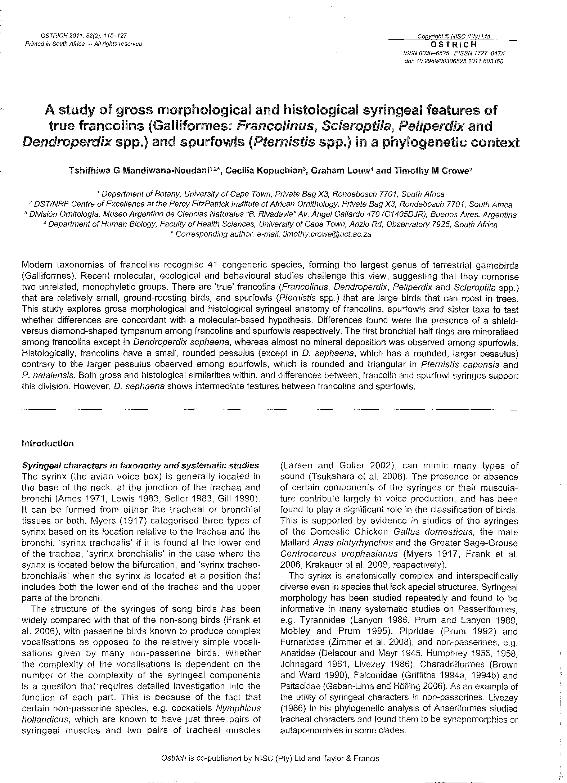Mostrar el registro sencillo del ítem
dc.contributor.author
Mandiwana Neudani, Tshifhiwa G
dc.contributor.author
Kopuchian, Cecilia

dc.contributor.author
Louw, Graham
dc.contributor.author
Crowe, Timothy M
dc.date.available
2018-04-17T14:43:06Z
dc.date.issued
2011-08
dc.identifier.citation
Mandiwana Neudani, Tshifhiwa G; Kopuchian, Cecilia; Louw, Graham; Crowe, Timothy M; A study of gross morphological and histological syringeal features of true francolins (Galliformes: Francolinus, Scleroptila, Peliperdix and Dendroperdix spp.) and spurfowls ( Pternistis spp.) in a phylogenetic context; Natl Inquiry Services Centre Pty Ltd; Ostrich; 82; 2; 8-2011; 115-127
dc.identifier.issn
0030-6525
dc.identifier.uri
http://hdl.handle.net/11336/42245
dc.description.abstract
Most modern taxonomic treatments of francolins consider the 41 currently recognized species as congeneric, forming the largest genus of terrestrial gamebirds (Order Galliformes). Some recent studies, based on molecular, ecological and behavioural characters have challenged this view, suggesting that they comprise two distantly related, monophyletic groups comprising. First, there are ‘true’ francolins’ (grouped within four genera Francolinus, Dendroperdix, Peliperdix and Scleroptila) that are relatively small, ground-roosting birds which give whistling and musical calls. Second are the spurfowls (placed into a single genus Pternistis) which unlike francolins are large birds that generally roost in trees and give raucous and grating calls. This study explores evidence from the gross morphological and histological syringeal anatomy of ‘true’ francolins, spurfowls and their putative sister taxa to test whether differences in syringeal morphology were concordant with an independently generated evolutionary hypothesis. The main syringeal differences found were the presence of shield- versus diamond-shaped tympanum among francolins and spurfowls respectively. The first bronchial half rings are relatively heavily mineralized among francolins except in Dendroperdix sephaena while almost no mineral deposition was observed in these rings among spurfowls. Histologically, francolins generally have a small, rounded pessulus (with the exception of D. sephaena which has a rounded but larger pessulus) contrary to the larger pessulus observed among spurfowls which is rounded and triangular in Pternistis capensis and P. natalensis respectively. Both gross and histological anatomical similarities within, and differences between, francolin and spurfowl syringes support the division of francolins into ‘true’ francolins and spurfowls, and reflects the previously proposed relationships with other sister species. However, as with other aspects of its organismal biology, D. sephaena shows features that are intermediate between francolins and spurfowls.
dc.format
application/pdf
dc.language.iso
eng
dc.publisher
Natl Inquiry Services Centre Pty Ltd

dc.rights
info:eu-repo/semantics/openAccess
dc.rights.uri
https://creativecommons.org/licenses/by-nc-sa/2.5/ar/
dc.subject
Phasianidae
dc.subject
Francolins
dc.subject
Spurfowls
dc.subject
Syringes
dc.subject.classification
Otras Ciencias Biológicas

dc.subject.classification
Ciencias Biológicas

dc.subject.classification
CIENCIAS NATURALES Y EXACTAS

dc.title
A study of gross morphological and histological syringeal features of true francolins (Galliformes: Francolinus, Scleroptila, Peliperdix and Dendroperdix spp.) and spurfowls ( Pternistis spp.) in a phylogenetic context
dc.type
info:eu-repo/semantics/article
dc.type
info:ar-repo/semantics/artículo
dc.type
info:eu-repo/semantics/publishedVersion
dc.date.updated
2018-04-05T18:18:19Z
dc.journal.volume
82
dc.journal.number
2
dc.journal.pagination
115-127
dc.journal.pais
Sudáfrica

dc.journal.ciudad
Johannesburg
dc.description.fil
Fil: Mandiwana Neudani, Tshifhiwa G. University of Cape Town; Sudáfrica. Centre of Excellence at the Percy Fitz Patrick Institute of African; Sudáfrica
dc.description.fil
Fil: Kopuchian, Cecilia. Consejo Nacional de Investigaciones Científicas y Técnicas. Oficina de Coordinación Administrativa Parque Centenario. Museo Argentino de Ciencias Naturales "Bernardino Rivadavia"; Argentina
dc.description.fil
Fil: Louw, Graham. University of Cape Town; Sudáfrica
dc.description.fil
Fil: Crowe, Timothy M. Centre of Excellence at the Percy Fitz Patrick Institute of African; Sudáfrica
dc.journal.title
Ostrich

dc.relation.alternativeid
info:eu-repo/semantics/altIdentifier/doi/http://dx.doi.org/10.2989/00306525.2011.603465
dc.relation.alternativeid
info:eu-repo/semantics/altIdentifier/url/https://www.tandfonline.com/doi/abs/10.2989/00306525.2011.603465
Archivos asociados
